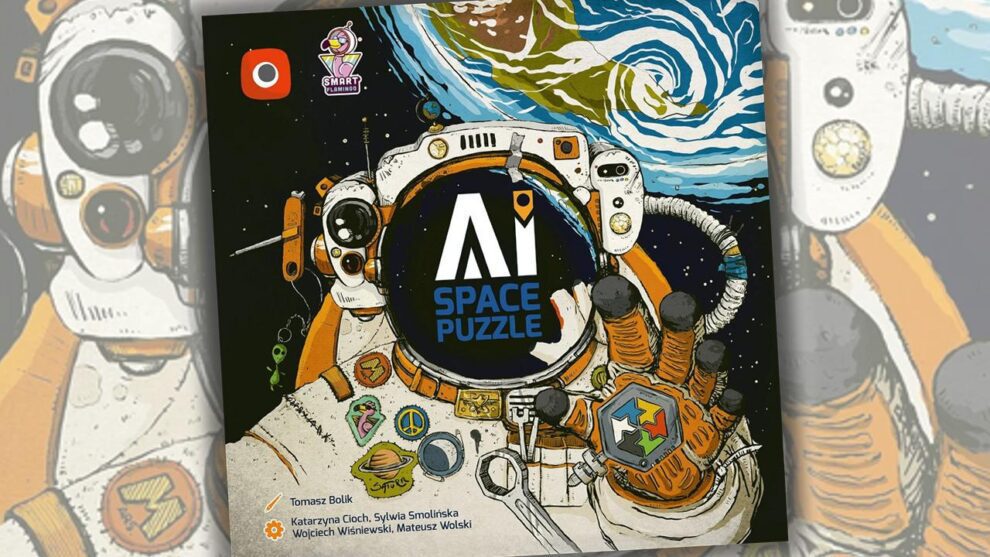Disclosure: Meeple Mountain received a free copy of this product in exchange for an honest, unbiased review. This review is not intended to be an endorsement.
“How was it for you?”
I looked up from behind my small player screen; my buddy Rex had asked the question. I was still processing, as I had just served as the AI player during a recent set of three back-to-back plays of AI Space Puzzle (2024, Portal Games).
AI Space Puzzle is a cooperative deduction game. The theme is loose enough to be nearly non-existent: one player is the damaged AI of a spaceship bound for trouble unless the astronauts of the ship can decipher the cryptic clues provided by the AI to ensure that each room of the ship is correctly unlocked using the proper security keys. (Abstract? Yep.)
AI Space Puzzle is really two games in one. The AI player is playing the first game and will have plenty to do in order to get the right astronauts in the right rooms in just the right number of turns, usually eight turns or less. With a small pile of communication tokens, the AI can hint at the best ways to solve each scenario, hoping that the mix of clever clues and a sprinkle of luck will win the day.
The astronauts are playing a different game, a game that sometimes has a good amount of downtime. The AI’s processing power is the speed at which your AI player can come up with great clues. But the astronauts can’t do anything while they are waiting—the AI player can’t talk, and the astronauts can only react to the clues shared to start each turn.
Across five plays with three different groups, here’s where I land on AI Space Puzzle: I love the first game. AI Space Puzzle is very interesting for the AI player to come up with clues. The restrictions in each round are a blast, as the AI tries to guide the astronauts to victory before the timer runs out.
For the astronauts, it’s really a crapshoot. Some astronauts (1-4 players in each game) will love being able to read the mind of the AI player and cooperatively knock out a win. Other astronaut players will hate waiting. Even though games of AI Space Puzzle usually take about 30 minutes, the game feels longer for the majority of the players at the table.

I’ve Got That Mysterium Feeling
On a turn, the AI uses a mix of about 15 communications tokens (more for easier scenarios, less for harder ones) to give astronauts clues. The scenarios—40 of which come with the game in a small booklet—are combined with a solution card that the AI player uses as a guide for the win condition.
In AI Space Puzzle, the astronauts have to recreate the same visual as the picture on the AI player’s solution card used for that game’s scenario. That means getting the correct astronaut pawns on the right spaces of a 4×4-tile grid, both location and pawn color. That also means getting the correct color markers on the four Security Key Cards, which are used by the astronauts as they fulfill parts of each scenario. Then each scenario has one or two rules tweaks that change the core mechanics, similar to an event card that breaks a rule for a specific playthrough.
Because the AI player cannot speak, AI Space Puzzle gave players a lot of those Mysterium (or its smaller/lighter cousin, Mysterium Park) vibes, where the ghost/spirit/gamemaster is trying to get everyone to see the solution by providing lots of little clues to the players. Like Mysterium, I had the most fun with AI Space Puzzle when I was the AI or “puppetmaster” working behind the scenes—in this case, an actual small cardboard screen—to use communication tokens to indicate that a certain pawn was in the right spot.

The other great thing about taking on the role of the AI? The AI player essentially creates a communication system over the first 2-3 turns of a scenario. “What do you think the AI is trying to say with that color token, the up arrow, and the five-pip die token?” a player might ask. Discussion amongst the astronauts ensues. The players slowly learned my style of clue delivery and leaned into that during each scenario.
Beating a scenario of AI Space Puzzle on the last turn led to a solid fist-pump moment from me as the AI player…but the astronauts never seemed as jazzed as I was. “I’m glad we worked that out,” one player noted after we beat an early scenario on the final turn. “But sometimes it took you longer to build the clues than for us to decipher them.”
And he was right. That wasn’t the only turn where that happened.
For my final review play, we did a scenario where I served as an astronaut and had a different player serve as the AI. Totally different game. It was interesting to analyze each clue and work with a partner to decipher the clue’s meaning, all while avoiding eye contact with the AI player to ensure they didn’t lean one way or the other as the astronauts were speaking.
But the astronaut game, while interesting, wasn’t nearly as cool as being the AI. Also, it’s fun to listen to the astronauts debate the structure of a clue. You had one thing in mind, but now the astronauts have a different thing in mind? How do I hide my disappointment?

A Tale of Two Deduction Experiences
Ultimately, the “wow” existed with AI Space Puzzle only when I was the AI player.
For the person who enjoys playing as the Mastermind in the game Mastermind, or the spirit behind the screen in Mysterium, I think AI Space Puzzle is very much worth a look if you have a dedicated group with whom you regularly play games, maybe one or two other players. (My five-player games of AI Space Puzzle were a negative—four astronauts working to solve clues together led to a decent amount of arguments as players sometimes overthought the clues of the AI player.)
As an astronaut player, AI Space Puzzle is harder to recommend. It’s a little harder to teach because there was confusion in every game about the reasons behind the Security Key Cards to track clues, along with the fact that players have to get the right color pawns and the right keys in the same locations. Once players get going, it’s not hard…in fact, it was easier to explain AI Space Puzzle to my kids (10 and 7) than adults because kids don’t want to overthink anything.
Playing this with the same group each time is absolutely the best way to play. Working through the entire 40-scenario booklet would be a fun challenge (again, with a single partner or maybe a second astronaut), a bit like The Crew: The Quest for Planet Nine uses its 50-scenario booklet to keep groups challenged with twisty rules changes.
A special shout-out to the production of AI Space Puzzle, particularly the economy with which it delivers its puzzle. The game, built by a mix of designers that include the people behind another Portal Games release, Gutenberg, has a rulebook that is only so-so. But some of the clue examples late in the scenario booklet do a nice job for the AI player in laying out how information can be delivered to the astronauts. The astronaut pawns come in six colors but the patterns on each pawn help colorblind players who experience issues deciphering certain colors.
Compared with other recent limited communication games like Sky Team and Décorum, AI Space Puzzle has created enough of its own niche to warrant giving this game a look if you are a fan of this type of game, particularly for the gamemaster. I could see this being a great filler that could run short or long for players who regularly game together and are looking for a change-up over The Crew and other cooperative deduction games.











